Special Hobby 1/32 Yak-3 “Normandie-Niemen”
The Yakovlev Yak-3 is commonly considered the best sub-type of the wartime Yakovlev fighter series that began with the Yak-1. The Yak-3 was one of the smallest and lightest major combat fighters fielded by any combatant; its high power-to-weight ratio gave it excellent performance. Top-scoring French ace of World War II Marcel Albert, who flew the type with the Normandie-Niémen Group, considered it superior to the P-51D Mustang and the Supermarine Spitfire in aerial combat.
The Yak-3's origins go back to 1941, when the I-30 was offered with the I-26 as an alternative to the Yak-1. The I-30 was powered by a Klimov M-105P engine and construction was all metal, with a wing incorporating dihedral on the outer panels. Armament was a 20 mm ShVAK cannon firing through the prop with twin 7.62 mm ShKAS machine guns in the fuselage, and a ShVAK cannon in each wing. The first prototype had a slatted wing to improve handling and short-field performance while the second had a wooden wing without slats, in order to simplify production. While plans were made to put this Yak-3 into production, the scarcity of aviation aluminum combined with the need to produce a large number of simple fighters quickly in the face of the Nazi invasion led to the first Yak-3 being abandoned in late 1941.
The Yak-1M that appeared in 1943 was a smaller and lighter version of the Yak-1. One Yak-1M prototype was constructed later that year that incorporated plywood instead of fabric covering the rear fuselage, a mastless radio antenna, reflector gunsight and improved armor and engine cooling and a Klimov VK-107 engine. Chief test pilot Petr Mikhailovich Stefanovskiy was so impressed he recommended the new aircraft should completely replace the Yak-1 and Yak-7 with only the Yak-9 remaining in production. The new fighter, designated quickly; by mid-1946, 4,848 had come off the production lines.
The Yak-3 was lighter and smaller than the Yak-9, while powered by the same engine. In service, it was found to be a forgiving, easy-to-handle aircraft loved by both rookie and veteran pilots and ground crew as well. It was robust and easy to maintain in primitive conditions.
The Yak-3 reached operational units during the summer of 1944, with service tests conducted by 91st IAP of the 2nd Air Army in June-July 1944. In one large battle on June 16, 1944, 18 Yak-3s fought 24 German aircraft, shooting down 15 for the loss of one Yak destroyed and one damaged. By the next day, Luftwaffe activity over that area of the front virtually ceased. That day, eight Yaks attacked a formation of 60 German Ju-87s and Bf-109Gs. In the battle, the Germans lost 3 Ju-87s and four Bf-109Gs for no Soviet losses. After this, the Luftwaffe issued an order to "avoid combat with Yak fighters without an oil cooler under the nose below 5000 meters".
The Yak-3 was far from perfect. Wartime production quality problems included plywood surfaces coming unstuck when pulling out of a high-speed dive, along with poor engine reliability and problems with the pneumatic system actuating landing gear, flaps and brakes, which was typical for all Yak fighters of the time.
The Normandie-Niemen Regiment:
G.C.III “Normandie” (3rd Fighter Group) of the Free French Air Force was formed in Syria on 1 September 1942, with 12 pilots and 47 maintenance personnel from the former Vichy French air force and members of the Free French air units that had refused to cooperate with the 1940 surrender to Germany. The unit was the result of talks between the Soviet Union and the Free French government to promote cooperation between the two governments.
The men arrived in the USSR in November and underwent training until March 1943. Given their choice of any Soviet or Western fighter, Commandant Poliquen and Commandant Tulasne chose the Yak-1 on the grounds it was most like the Dewoitine D.520 with regard to performance and handling. After training on 2-seat Yak-7UTI trainers, they entered combat in March 1943, with a first victory over an Fw-190 on 5 April. That summer, they participated in the Battle of Kursk, where they established themselves as a successful air combat unit.
Tulasne was killed in combat in July, and was replaced as commander by Commandant Pierre Pouyade. Soviet propaganda about the unit's activities had resulted in an order by German Field Marshal Wilhelm Keitel that any captured French pilot be executed. That fall, more pilots were recruited in North Africa and by early 1944 there were enough trained pilots to form three Escadrilles in the Group. That spring they re-equipped with the Yak-9 and participated in the Soviet offensive that began in June. That summer, they were prominent in the Niemen River campaign, and in August Stalin named them “Normandie-Niemen” and they were allowed to paint their spinners in the tricolor in recognition of their 174 aerial victories.
In late August, the group was re-equipped with the new Yak-3 and took part in the drive into East Prussia and Poland, ending with the Battle of Berlin, during which they scored an additional 99 victories.
Among the leading members of the Normandie-Niemen was Commandant Louis Delfino. Delfino had joined the air force in 1934 and scored 7 victories and 3 probables while flying the Bloch M.B. 152C fighter as an Escadrille commander in G.C. I/4 during the Battle of France in 1940. He had remained in the Armee de l'Air after the Armistice and was stationed at Dakar in French West Africa, where he later shot down a Wellington bomber on 8 August 1942. Delfino volunteered to go to the USSR in January 1944 and arrived in February. He became commander of the 1st Escadrille of Normandie-Niemen in June 1944. He scored his first Eastern Front victory on 16 October at the outset of the East Prussia offensive. In November, by which time he had scored 5 victories over Fw-190s, he was promoted to second in command of the Group. He scored four more victories by April 1945. On 26 April he was promoted to Lt. Colonel and given command of the Normandie-Niemen. He led the unit to Paris on 20 June 1945. He remained in the Armee de l'Air after the war and rose to Inspector General in 1964 before dying of a heart attack on 11 June 1968.
The Normandie-Niemen regiment claimed 273 enemy aircraft shot down and 37 probables. Losses were 87 aircraft and 52 pilots. 5,240 sorties were flown and the unit took part in 869 dogfights. They also destroyed 27 trains, 22 locomotives, two E-boats, 132 trucks, and 24 staff cars. Forty-two pilots were killed and 30 became aces.
THE KIT
There have been several Yak-3 kits issued over the years, the best of which is the 1/48 kit produced by Zvezda. This Special Hobby kit is the first in 1/32 scale. The “Hi-Tech” release includes resin detail parts, the most useful of which are the resin tires, which include tread and full side detail, as well as photoetch that includes seat belts. The injection-molded parts are to the same high production level as the recently-released Tempest kits, indicative of a new quality level overall from Special Hobby. Decals are provided for five different aircraft flown by aces of the Normandie-Niemen.
While this kit is very high quality in design and parts production, it is still a limited run kit, and the rules of limited run kits apply: test fit three times before gluing once. I followed the instructions and began with the cockpit. I followed the painting instructions, then assembled the cockpit, which presented no difficulties. I glued the fuselage together and rubber-banded it to set up. I particularly liked the separate upper engine cowling piece, which meant there was no centerline seam to deal with there.
While that set up, I assembled the wheel wells and glued them in position, then assembled the wing and rubber-banded it to set up. The fuselage and wing sub-assemblies fitted without problem, and were glued into position. I followed that by attaching the horizontal stabilizers and the separate elevators and rudder. Overall, this was one of the easiest-assembling Special Hobby kits I have done. I only used Mr. Surfacer 500 on the fuselage centerline seams and to fill gaps where the horizontal stablizers were glued to the fuselage.
I used Tamiya paints for the camouflage. I mixed a “light blue with Tamiya “Sky Blue” and “White” for the lower surfaces. I mixed Tamiya RLM Grey” with “Light Grey” to get the light grey upper surface color and used “Dark Grey” for the dark color. The camouflage was painted using the paint scheme supplied in the kit (which differs from airplane to airplane). I gave the model a coat of Future before applying decals.
Special Hobby decals are nice, but they are too thin and will fold up at the first opportunity. I painted them with Michro-Scale Liquid Decal Film, then applied them without any difficulty. They set down without problem under Micro-Sol.
I applied an overall coat of Micro-Coat “Satin” to the model, since Soviet Fighters were covered with a thick polish at the factory. I then attached the landing gear and unmasked the canopy, setting the sliding section in the open position.
This is one of Special Hobby's best kits. It assembles easily and presents no problems so long as you take your time to test fit and clean up sprue nubs and such.
Soviet fighters are rare on the ground in 1/32, so this is a welcome addition (the others are the Special Hobby I-16 series, the Trumpeter MiG-3 and the Alley Cat Yak-1b resin kit). The Yak-3 is aesthetically one of the nicest looking fighters of the Second World War. Any modeler with experience doing limited-run kits will have no problem creating a good looking model.
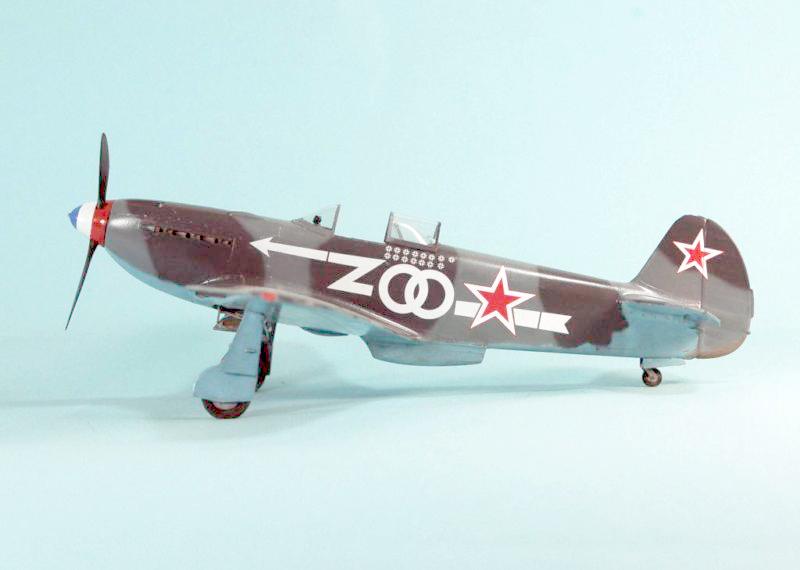
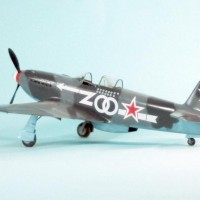
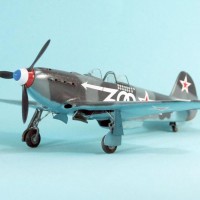
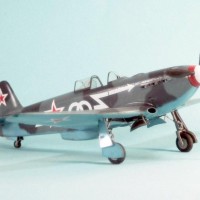

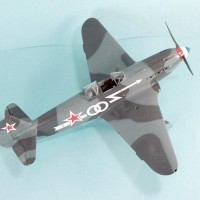
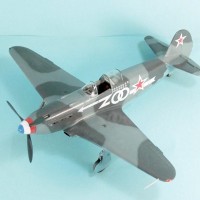

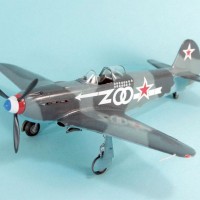
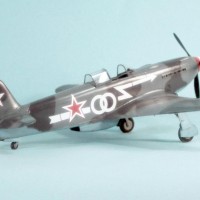
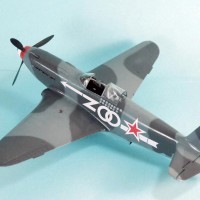
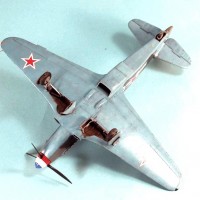
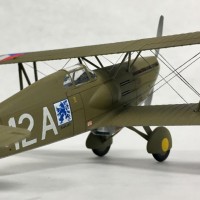
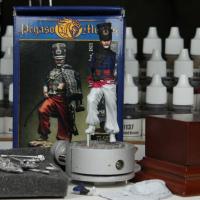
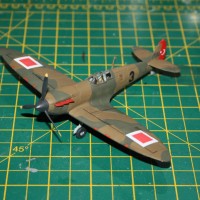
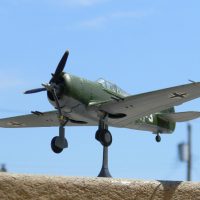
THAT'S a beauty. One of the cleanest aircraft designs ever. Gotta git one.
Nice build...nice pics...nice job.
Looks great Tom !
The Yak is also a very small plane in real life. It would be dwarfed by a P-47. Excellent work on your build and the article was fantastic. Thanks for sharing this with us.
Yeah, we have one of the "new build" Yak-3s at Chino and it is much smaller than a P-40.
Very neat clean build, you did an excellent job with those decals.
Another nice build Tom. Agree that it is a very pleasing aircraft - nice clean lines - all business and no frills!
🙂 ... Greetings ... 🙂 :
Great work on that YAK-3 Tom. This is a type not seen much and much less in what I consider to be my favorite WW2 fighter scale (1/32).
This one for sure makes for a good display piece ... job well done.
Outstanding, Tom. I like the history lesson you provided before the "build" section. I wish more folks would do this. Thanks!
Nice work
Anyone had a bash at the Silver Wings Yak 9?